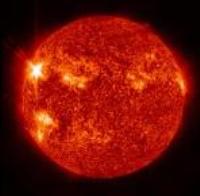Jan 10 2014
The first powerful "X-class" solar flare of 2014, in association with another solar phenomenon, a giant cloud of solar particles known as a coronal mass ejection (CME), erupted from the sun on Tuesday, sending radiation and particles speeding toward Earth and disrupting operations on the ground.
 Credit: NASA
Credit: NASA
NASA reported on Wednesday that Orbital Sciences Corp., a commercial spaceflight company on a cargo delivery mission to the International Space Station, had called off its rocket launch that day from the agency's Wallops Flight Facility in Virginia because of the unusually high levels of radiation.
"This was a huge event, with the CME now classified as an R-type for its rarity, with an estimated speed much higher than we have recently seen because of the massive release of energy," commented Andrew Gerrard, an NJIT professor of physics and deputy director of the university's Center for Solar-Terrestrial Research. "Eruptions of this magnitude can cause circulation changes in the upper atmosphere, communications disruptions in space and on the ground, and other potential electrical anomalies. We can lose track of space craft, whose orbits can be disrupted by these in these events. It's like driving through molasses."
NJIT is continuing to measure the solar explosion's impact from space with its instruments on the Van Allen Probes, NASA space craft that travel through the inner magnetosphere, and on the ground through instruments like those in the NATION Fabry-Perot systems in North America, which measure thermospheric winds and temperatures, and in systems across the Antarctic plateau that measure geomagnetic variability.
"This is a beautiful opportunity to look at how this material from the sun is injected into the radiation belts, inner magnetosphere, and upper atmosphere," Gerrard said. "We may not see anything like this for another decade."
NJIT's Center for Solar-Terrestrial Research also operates the university's Big Bear Solar Observatory (BBSO) in California, which is home to the world's most powerful ground-based telescope dedicated to solar research. NJIT professors at BBSO in Big Bear have obtained new and remarkably detailed photos of the Sun with the New Solar Telescope (NST).
The flare, a giant burst of radiation designated as X-class for the most intense flares, is centered over a giant sunspot AR1944 located at the center of the sun. By Wednesday, the solar radiation storm had intensified to an S3 or strong event, while the coronal mass ejection was forecast to set off G3 (Strong) Geomagnetic Storm activity through January 9 and 10, NASA said.
Solar flares and coronal mass ejections regularly send bursts of charged particles and high energy radiation in Earth's direction at nearly the speed of light. Upon reaching our atmosphere within minutes, solar radiation can destroy the electronic systems in satellites used in telecommunications, weather forecasting and GPS systems, among other services, as well as devices on the ground, such as transformers.
In 1989, for example, a solar storm brought down the Hydro-Quebec grid within minutes, blacking out the entire province as well as parts of the Northern United States for several hours.